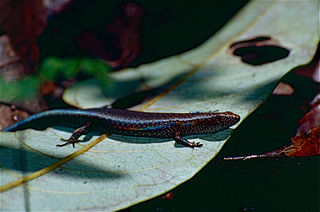
Lampropholis is a genus of skinks, commonly known as sunskinks, in the lizard subfamily Eugongylinae of the family Scincidae. The genus Lampropholis was previously found to belong to a clade with the genera Niveoscincus, Leiolopisma and others of the Eugongylus group within Lygosominae. All species of Lampropholis are endemic to Australia. For similar skinks see genera Bassiana, Pseudemoia, and Niveoscincus.
Anomalopus mackayi, commonly known as the five-clawed worm skink, long-legged worm skink, and Mackay's burrowing skink, is a species of smooth-scaled burrowing skink, a lizard in the family Scincidae. The species is endemic to eastern Australia.
Allan's lerista, also known commonly as Allan's skink and the greater robust fine-lined slider, is a species of skink, a lizard in the family Scincidae. This rare species is endemic to Queensland, Australia.

Bougainville's skink is a species of skink, a lizard in the family Scincidae. This species is also commonly called the south-eastern slider and Bougainville's lerista.
The Satinay sand skink, also known commonly as the Fraser Island sand skink, is a species of lizard in the family Scincidae. The species is native to Australia.

The major skink is a species of lizard in the family Scincidae. The species is native to part of Australia and part of Australasia.

The eastern mourning skink, also known commonly as Coventry's spinytail skink and the swamp skink, is a species of lizard in the family Scincidae. The species is endemic to Australia.
The red-tailed soil-crevice skink, also known commonly as Kinghorn's grassland striped skink and Kinghorn's snake-eyed skink, is a species of skink, a lizard in the subfamily Eugongylinae of the family Scincidae. The species is endemic to Australia.

Carlia schmeltzii, known commonly as the robust rainbow-skink, is a species of lizard in the family Scincidae. The species is endemic to Australia.
Lampropholis adonis, also known commonly as the diamond shielded sunskink and Ingram's litter skink, is a species of skink, a lizard in the family Scincidae. The species is endemic to Queensland in Australia.

Lampropholis coggeri, also known commonly as the northern sun skink and the rainforest sunskink, is a species of lizard in the family Scincidae. The species is endemic to Queensland in Australia.

Lampropholis couperi, commonly known as the plain-backed sunskink, is a species of skink, a lizard in the family Scincidae. The species is endemic to Queensland, Australia.
Lygisaurus tanneri, also known commonly as the Endeavour River litter-skink and Tanner's four-fingered skink, is a species of lizard in the family Scincidae. The species is endemic to Australia.

Saproscincus challengeri, also known commonly as the Border Ranges shadeskink, Challenger's skink, the challenging shade skink, and the orange-tailed shadeskink, is a species of lizard in the family Scincidae. The species is native to New South Wales and Queensland in Australia.

Saproscincus czechurai, also known commonly as Czechura's litter-skink, Czechura's skink, and the wedge-snouted shadeskink, is a species of lizard in the family Scincidae. The species is endemic to Queensland in Australia.
Ctenotus eurydice, also known commonly as the brown-backed yellow-lined ctenotus, is a species of skink, a lizard in the family Scincidae. The species is native to New South Wales and Queensland in Australia.
Ctenotus ingrami, also known commonly as Ingram's ctenotus and the unspotted yellow-sided ctenotus, is a species of skink, a lizard in the family Scincidae. The species is native to Queensland and New South Wales in Australia.

Eulamprus kosciuskoi, also known commonly as the alpine meadow-skink and the alpine water skink, is a species of lizard in the subfamily Sphenomorphinae of the family Scincidae. The species is native to eastern Australia.
The nubbinned fine-lined slider is a species of skink, a lizard in the family Scincidae. The species is endemic to Queensland in Australia.
Lerista emmotti, also known commonly as the Noonbah robust slider, is a species of skink, a lizard in the family Scincidae. The species is endemic to Queensland in Australia.










